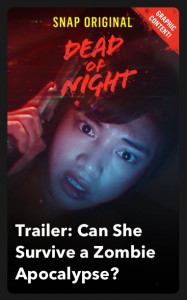As the entertainment landscape evolves, so do the opportunities for actors to showcase their talents. One of the most exciting developments in recent years is the rise of vertical TV series. Designed specifically for mobile viewing, these series are transforming how stories are told and consumed. For actors, this shift opens up a new world of possibilities to reach audiences in a fresh and engaging way.
 Vertical TV series, with their unique 9:16 aspect ratio, are crafted to fit the natural orientation of smartphones. This format emphasizes close-ups and intimate storytelling, allowing actors to connect with viewers on a more personal level. The short, dynamic episodes cater to the quick consumption habits of mobile users, making each performance crucial in capturing and retaining the audience’s attention.
Vertical TV series, with their unique 9:16 aspect ratio, are crafted to fit the natural orientation of smartphones. This format emphasizes close-ups and intimate storytelling, allowing actors to connect with viewers on a more personal level. The short, dynamic episodes cater to the quick consumption habits of mobile users, making each performance crucial in capturing and retaining the audience’s attention.
As an actor, embracing this format can be a game-changer for your career. Whether you’re looking to break into the industry or expand your portfolio, vertical TV series offer a platform to showcase your versatility and adapt to new trends in content creation. Let’s explore what makes vertical TV series so revolutionary and how you can leverage this opportunity to shine on the small screen.
Here’s a detailed breakdown of a vertical TV series:
Key Features
- Aspect Ratio:
- Vertical Format: Typically, vertical TV series are produced in a 9:16 aspect ratio, matching the way people commonly hold their phones.
- Content Style:
- Short Episodes: Episodes are often shorter, ranging from a few minutes to about 10 minutes, to suit the quick consumption habits of mobile users.
- Fast-Paced Storytelling: The storytelling style is usually more dynamic and fast-paced to maintain viewer engagement on mobile devices.
- Production Techniques:
- Optimized Framing: Shots are framed to make the most of the vertical space, focusing on close-ups and single-subject scenes.
- Minimalistic Backgrounds: The use of minimalistic and straightforward backgrounds helps keep the focus on the characters and action.
- User Interaction:
- Swipe Navigation: Users can swipe vertically to navigate through episodes or series, enhancing the interactive experience.
- Integration with Social Media: These series are often integrated with social media platforms for easy sharing and discussion.
- Platform Distribution:
- Mobile-First Platforms: Vertical TV series are primarily distributed through mobile-first platforms such as Quibi (when it was active), Snapchat, TikTok, and Instagram TV (IGTV).
Advantages
- Convenience:
- Mobile Optimization: Designed specifically for mobile viewing, making it more convenient for users who primarily consume content on their phones.
- Engagement:
- Short Duration: Shorter episodes cater to the modern audience’s preference for quick, snackable content, increasing viewer retention.
- Innovation:
- Creative Freedom: Allows creators to experiment with new storytelling techniques and formats tailored to vertical viewing.
Examples
-
- “Snap Originals” on Snapchat:
- “Dead of Night”: A horror series where a woman battles zombies in a city under lockdown.
- “Endless Summer”: A reality series following a group of friends in Laguna Beach.
- “IGTV Series” on Instagram TV:
- “Unfiltered: Paris Jackson”: A docuseries offering an intimate look into the life of Paris Jackson.
- “Let’s Talk About It”: A series by Jada Pinkett Smith and Willow Smith discussing mental health and other important issues.
- “Quibi Originals” (though Quibi is no longer operational, its shows were popular):
- “Most Dangerous Game”: A thriller starring Liam Hemsworth and Christoph Waltz, where a man participates in a deadly game to secure his family’s future.
- “Reno 911!”: A revival of the popular comedy series, reimagined for the vertical format.
- TikTok Series:
- “Attaway General”: A drama series about teenagers volunteering at a hospital, produced by Brat TV.
- “VIRAL”: A series exploring the lives of social media influencers.
- “Snap Originals” on Snapchat:
By tailoring the content to the way people naturally use their devices, vertical TV series provides an immersive and engaging viewing experience for mobile audiences.

